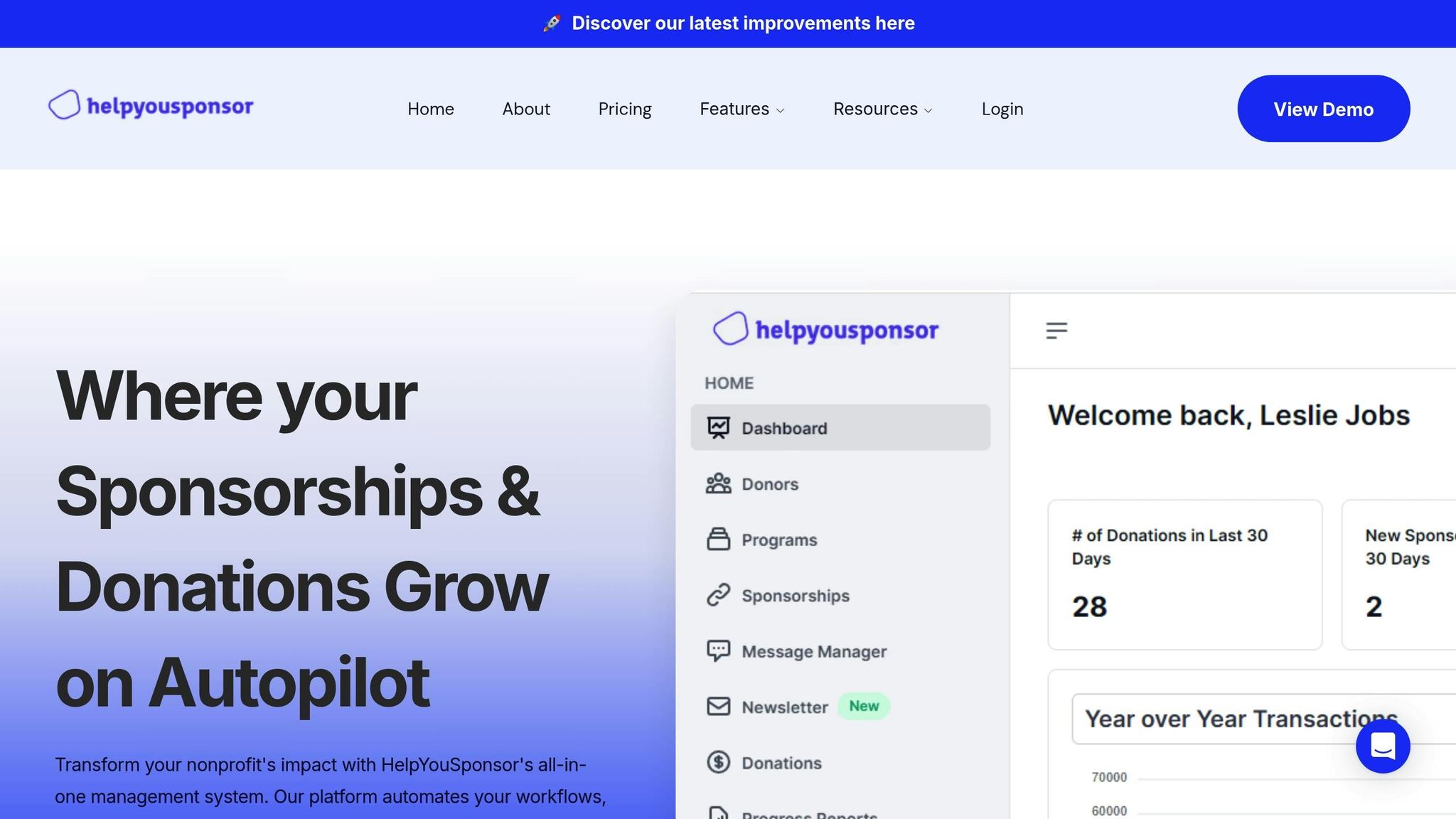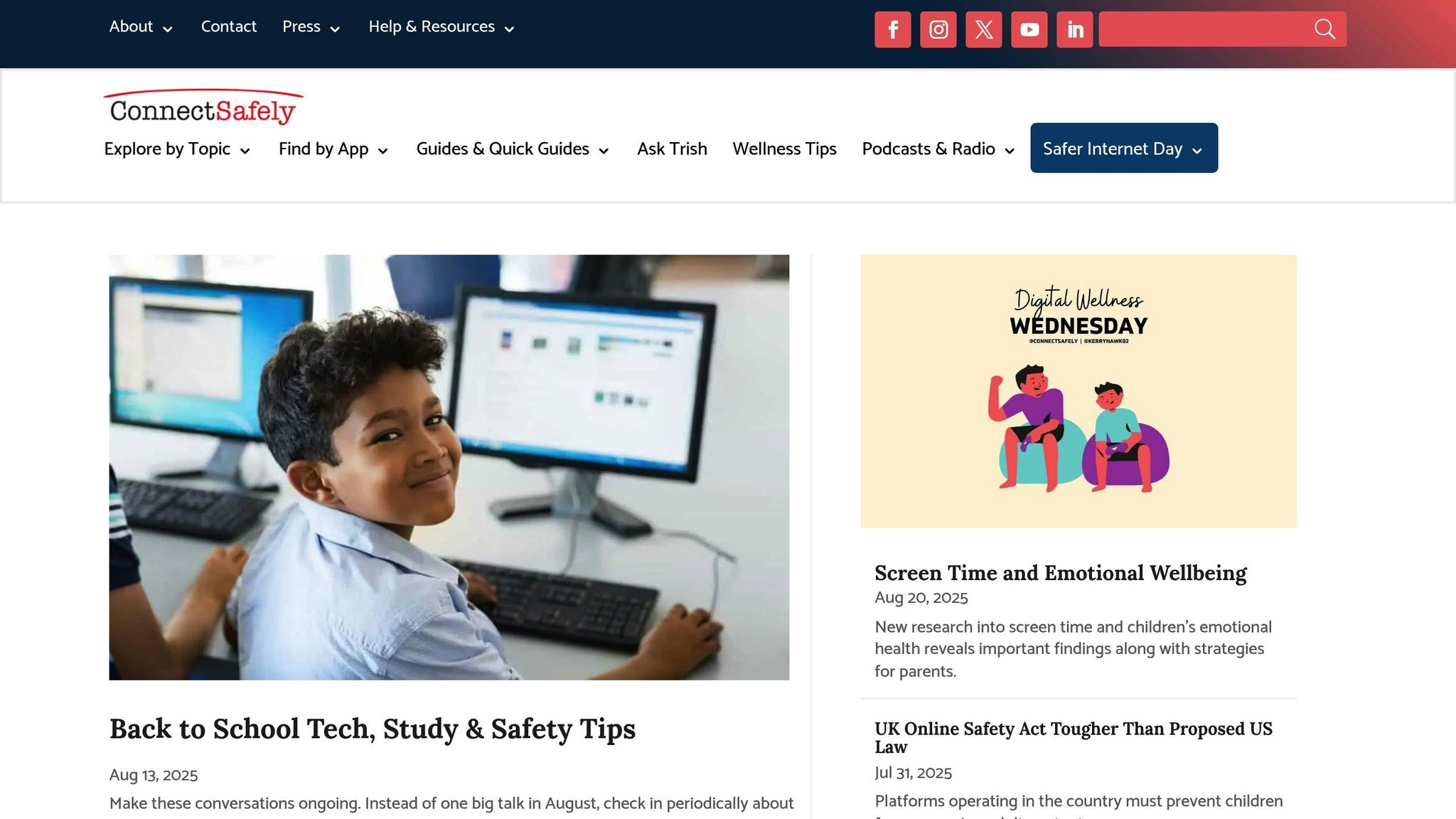Child Safe Digital Engagement: Best Practices
Explore effective frameworks for nonprofits to ensure safe digital interactions with children, focusing on privacy, compliance, and educational resources.

Digital safety for children is a growing concern, especially for nonprofits engaging with young audiences online. This article explores three frameworks to help organizations ensure secure digital interactions:
- HelpYouSponsor: Focuses on privacy and secure communication for child sponsorship programs. Priced at $39/month, it offers features like secure authentication and role-based access controls.
- ConnectSafely: Provides free resources like safety checklists, policy templates, and training materials to protect children online. It emphasizes compliance with regulations like COPPA.
- U.S. Kids Online Health & Safety Task Force Guidance: Recommends voluntary practices such as default high-privacy settings and systems to prevent harmful behaviors. These steps prepare organizations for potential future regulations.
Key takeaway: Nonprofits can combine these tools to create safer digital spaces. Use HelpYouSponsor for secure sponsorship management, ConnectSafely for educational resources, and Task Force guidelines for long-term safety practices.
Beyond Safety: Fostering Wellbeing, Belonging, and Positive Digital Interactions for Children
1. HelpYouSponsor

HelpYouSponsor is designed to help nonprofits create secure and child-safe digital interactions. With a strong focus on privacy and security, the platform ensures that sensitive information is protected while enabling responsible digital engagement. This thoughtful approach provides a solid foundation for organizations to manage security effectively.
The platform incorporates secure authentication, role-based access controls, and seamless workflow integration to safeguard data. These features work hand-in-hand with internal safety policies, offering nonprofits a reliable way to maintain privacy and control. Its user-friendly interface makes it simple to adjust privacy settings, ensuring a safe and controlled digital environment that prioritizes child safety.
In a world where digital engagement requires unwavering security, HelpYouSponsor provides nonprofits with a trusted solution that supports best practices for child-safe interactions.
2. ConnectSafely

ConnectSafely is a nonprofit organization dedicated to promoting child-safe digital practices. They offer a wide range of educational resources, policy guidelines, and actionable tools that organizations can adapt to meet their specific needs. Let’s explore the features that make ConnectSafely a key player in digital safety.
Digital Protection Features
ConnectSafely focuses on layered safety strategies that extend well beyond basic privacy settings. Their framework includes tools like content filtering, monitoring systems, and age-appropriate protocols. They also provide checklists for user verification and ongoing safety evaluations, giving organizations a solid foundation for protecting children online.
The organization’s resources are designed to establish clear communication boundaries in digital spaces. They offer templates for acceptable use policies, incident reporting systems, and emergency response plans. These tools help nonprofits create structured, safe environments where children can participate in programs while staying protected.
Another key offering is their guidance on choosing technology with safety in mind. ConnectSafely provides recommendations for evaluating platforms based on features like data encryption, user verification processes, and content moderation capabilities. This helps organizations select tools that align with their child protection goals.
Compliance with U.S. Standards
ConnectSafely ensures its guidelines align with COPPA and state-specific regulations, breaking down complex legal requirements into easy-to-follow steps. This makes compliance manageable, even for organizations without extensive legal resources.
Their framework provides clear instructions on data collection limits, consent procedures, and record-keeping practices. For example, they guide nonprofits on what types of information can be collected from minors, how to secure proper permissions, and how long sensitive data should be retained. This reduces the risk of compliance issues while allowing programs to run smoothly.
ConnectSafely also stays ahead of regulatory changes, regularly updating their resources to address new laws and emerging safety concerns. Their materials are tailored for different age groups, recognizing that the needs of younger children differ from those of teenagers.
Implementation Process
ConnectSafely offers a step-by-step implementation guide that organizations can adapt based on their size and program complexity. This process includes conducting safety audits, developing policies, training staff, and setting up ongoing monitoring systems.
A standout feature of their approach is the emphasis on stakeholder involvement. Parents, children, and staff are all engaged in shaping safety protocols, ensuring the measures are both practical and effective for day-to-day operations.
Rather than pushing for immediate, sweeping changes, ConnectSafely promotes a phased implementation strategy. This allows organizations to test new safety measures, gather feedback, and make adjustments before fully rolling them out. This method minimizes disruptions while ensuring comprehensive safety across all digital interactions.
3. U.S. Kids Online Health & Safety Task Force Guidance
The U.S. Kids Online Health & Safety Task Force recently shared its report titled "Best Practices for Families and Guidance for Industry," which focuses on strategies to protect children in digital spaces. This report lays out steps for online service providers to prioritize youth safety, privacy, and overall well-being. Similar to other key frameworks, it offers practical recommendations to help create safer online experiences for children.
Digital Protection Features
The report highlights ten essential practices that organizations can adopt to ensure age-appropriate digital environments. For example, it suggests reducing features that encourage excessive use, such as follower counts and "like" metrics, which should be disabled by default for younger users.
Another important aspect is the use of data-driven detection tools. These tools help platforms identify and address harmful behaviors like cyberbullying and harassment before they escalate.
Compliance with U.S. Standards
Although the Task Force's recommendations are voluntary for now, they hint at possible federal regulations in the future. Companies that adopt these practices early are likely to be better prepared for any upcoming legal requirements.
One key recommendation is that platforms should default to the highest privacy settings for young users, eliminating the need for them to manually opt in. This approach ensures that privacy protections are built into the system from the start.
Transparency is another critical focus. Platforms are encouraged to provide clear explanations of their safety features, data collection methods, and any associated risks. By doing so, they empower parents and young users to make informed choices about their online interactions.
The report also urges organizations to address bias and discrimination in their systems, ensuring that all users are treated fairly.
Implementation Process
To put these recommendations into action, nonprofits and organizations can take several steps. For instance, they can implement customizable parental controls, enabling families to tailor safety settings to their needs.
Clear safety disclosures are another priority. Platforms should explain how they handle user data and apply protective measures in a way that's easy to understand.
A major focus is on preventing child sexual exploitation. The report advises platforms to establish robust detection and reporting systems to identify and address suspicious activities effectively.
Advantages and Disadvantages
When nonprofits explore strategies for child-safe digital engagement, it's essential to weigh the benefits and limitations of available tools. By understanding these trade-offs, organizations can select the resources that align with their mission and effectively protect young users.
Here’s a closer look at the advantages and challenges of three prominent frameworks:
HelpYouSponsor
HelpYouSponsor focuses on essential sponsorship needs, limiting data collection to what's necessary and providing a straightforward interface for secure communication and donor management. However, its specialized scope means nonprofits looking for broader digital engagement tools may need to pair it with other resources.
ConnectSafely
ConnectSafely shines in digital citizenship education, offering a wealth of materials and guidelines for children, parents, and educators. While its resources are comprehensive, nonprofits may need to adapt these general recommendations to fit the specific requirements of child sponsorship programs.
U.S. Kids Online Health & Safety Task Force Guidance
The U.S. Kids Online Health & Safety Task Force provides a forward-thinking regulatory framework with actionable steps to enhance digital safety. However, as compliance is voluntary, smaller nonprofits might find it necessary to adjust the recommendations to suit their capabilities and resources.
| Resource | Main Advantages | Main Limitations |
|---|---|---|
| HelpYouSponsor | Focused on child sponsorship; limited data collection; easy to use | Limited to sponsorship management, not suited for broader needs |
| ConnectSafely | Offers extensive educational resources; wide reach | Requires customization for nonprofit-specific applications |
| Task Force Guidance | Provides actionable, forward-thinking steps | Voluntary compliance; may require significant adjustments |
HelpYouSponsor is priced at $39/month, while ConnectSafely's materials are free but may require internal effort for implementation. Task Force guidance, while free, often involves additional technical adjustments and ongoing monitoring.
Implementation Considerations
Setting up HelpYouSponsor is relatively straightforward, with built-in safety features that require minimal configuration. On the other hand, ConnectSafely's resources need to be tailored to specific organizational needs, and implementing the Task Force's framework may demand more significant technical effort and long-term oversight.
For nonprofits focused on child sponsorship, combining these resources can be a smart strategy. Using HelpYouSponsor for core sponsorship tasks, supplemented with ConnectSafely's educational insights and the structured practices from the Task Force guidance, creates a well-rounded approach. This blend ensures nonprofits meet high digital safety standards while addressing their unique operational goals.
Conclusion
Creating safe digital spaces for children involves combining the right tools, educational initiatives, and regulatory measures.
Each resource contributes uniquely to this effort. HelpYouSponsor ensures secure sponsorship management, while ConnectSafely offers valuable training tools and resources to strengthen internal safety measures. Additionally, guidance from the U.S. Kids Online Health & Safety Task Force provides essential recommendations for maintaining long-term digital safety compliance. Together, these elements equip nonprofits to safeguard children while enhancing their digital outreach.
FAQs
What steps can nonprofits take to comply with digital safety laws like COPPA when engaging with children online?
To align with COPPA and safeguard children's online privacy, nonprofits need a well-structured compliance plan. This plan should prioritize obtaining verifiable parental consent before collecting any personal details from children. It’s also crucial to practice data minimization - only gather the information that’s absolutely necessary - and maintain complete transparency about how data is collected, used, and stored.
Nonprofits should also rely on secure parental consent tools, keep a close eye on any third-party tools or scripts integrated into their platforms, and stay updated on changes to digital safety regulations. Following these steps not only ensures compliance with the law but also strengthens trust with families and the broader community.
What are the best ways to protect children’s privacy and prevent harmful behavior on digital platforms?
To keep kids safe online and protect their privacy, start with high-privacy default settings like age verification and limiting data collection. These steps help shield their personal information. Adding parental controls and monitoring tools can provide extra protection by filtering unsuitable content and managing screen time effectively.
It's also crucial to teach kids about online safety. Explain why privacy matters, encourage responsible online behavior, and warn them about the risks of sharing personal details. By combining these approaches, you can create a safer digital environment that prioritizes their well-being and privacy.
What are the best practices for nonprofits to create a child-safe digital engagement strategy using tools like HelpYouSponsor, ConnectSafely, and the U.S. Kids Online Health & Safety Task Force guidelines?
Nonprofits aiming to build a child-safe digital engagement strategy can draw from a mix of reliable tools and expert guidelines. For example, HelpYouSponsor provides features like secure data management and reporting tools, which are designed to protect privacy and ensure compliance with regulations. Additionally, ConnectSafely offers practical resources, such as parental controls and monitoring tips, to help keep an eye on kids' online activities. The U.S. Kids Online Health & Safety Task Force highlights the importance of clear communication, age-appropriate controls, and educating children about safe internet use.
By combining these resources, nonprofits can create a multi-layered approach to digital safety. This means focusing on privacy, using monitoring tools effectively, and encouraging open conversations to build a secure and welcoming online space for children.

